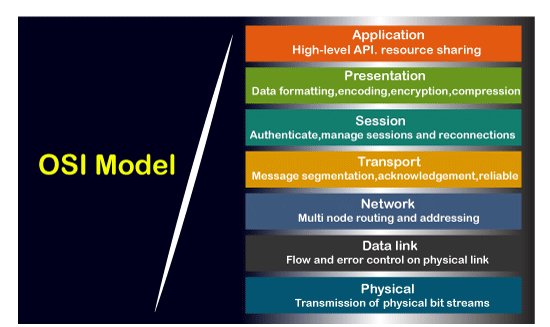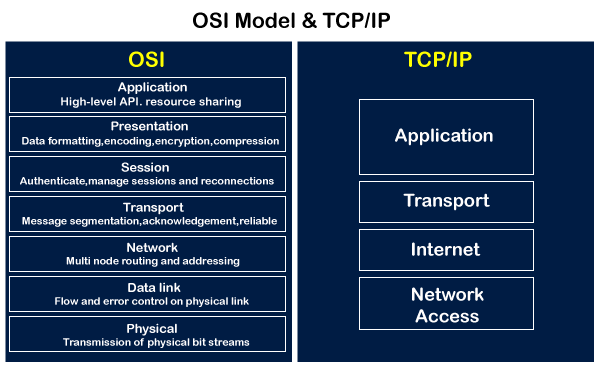- OSI、TCP/IP 和混合模型
- TCP/IP 模型
- TCP/IP 模型和 OSI 模型之间的相似之处
- TCP / IP模型和OSI模型之间的相似性
- TCP IP模型和OSI模型之间的相似性(1)
- TCP IP模型和OSI模型之间的相似性(1)
- TCP / IP模型和OSI模型之间的相似性
- TCP/IP 的历史
- 计算机网络中的TCP / IP
- TCP
- TCP(1)
- 无线通信-TCP IP(1)
- 无线通信-TCP / IP
- IPv4-TCP IP模型(1)
- IPv4-TCP / IP模型
- TCP / IP端口及其应用
- TCP IP端口及其应用(1)
- 这正是我们在拥有 TCP/IP 模型时仍然使用 OSI 模型的原因
- OSI数字面试体验
- OSI数字面试体验(1)
- OSI 完整表格
- OSI 完整表格
- OSI 完整表格(1)
- OSI 完整表格(1)
- 我的 ip (1)
- ip (1)
- 前 50 个 TCP/IP 面试问题和答案
- 电脑网络| TCP IP模型(1)
- 电脑网络| TCP / IP模型
📅 最后修改于: 2020-11-10 04:42:43 🧑 作者: Mango
OSI与TCP / IP
什么是OSI模型?
OSI代表于1980年代开发的开放系统互连。它是用于网络通信的概念模型。它没有完全实现,但今天仍然引用。该OSI模型由七个层组成,并且每个层相互连接。数据在OSI模型中向下移动,并且每一层都添加了附加信息。数据向下移动,直到到达OSI模型的最后一层。当在OSI模型的最后一层接收到数据时,数据将通过网络传输。一旦在另一侧到达数据,该过程将被逆转。

什么是TCP / IP模型?
TCP模型代表传输控制协议,而IP代表互联网协议。 TCP / IP模式下可能有许多使互联网成为可能的协议。如今,我们很少听到TCP / IP模型的名称,我们通常听到的是IPv4或IPv6的名称,但是它仍然有效。该模型包括4层。现在,我们将看一下TCP / IP模型的图形表示。

如上图所示,TCP / IP模型具有4层,而OSI模型则由7层组成。从图中可以看出,TCP / IP模型的4层完全适合OSI模型的7层,但这不是事实。 TCP / IP模型的应用程序层映射到前三层,即OSI模型的应用程序,会话和表示层。 TCP的传输层直接映射到OSI模型的传输层。 TCP / IP模型的Internet层直接映射到OSI模型的网络层。 OSI模型的最后两层映射到TCP / IP模型的网络层。与OSI模型相比,TCP / IP是最广泛使用的模型,用于通过Internet提供计算机之间的通信。
OSI和TCP / IP模型之间的相似之处
以下是OSI和TCP / IP模型之间的相似之处:
- 共享通用架构
这两个模型都是逻辑模型,并且具有相似的体系结构,因为这两个模型都是使用层构建的。
- 定义标准
这两层都定义了标准,并且它们还提供了用于实现标准和设备的框架。
- 简化故障排除流程
两种型号都将复杂的函数分解为更简单的组件,从而简化了故障排除过程。
- 预定义标准
已经预先定义的标准和协议;这些模型没有重新定义它们;他们只是引用或使用它们。例如,在开发这些模型之前,IEEE已经定义了以太网标准。模型没有重新创建它们,而是使用了这些预定义的标准。
- 两者具有“传输”和“网络”层的相似功能
其在“呈现”和“网络”层之间执行的函数类似于在传输层执行的函数。
OSI和TCP / IP模型之间的差异

让我们以表格形式查看OSI和TCP / IP模型之间的区别:
| OSI Model | TCP/IP Model |
|---|---|
| It stands for Open System Interconnection. | It stands for Transmission Control Protocol. |
| OSI model has been developed by ISO (International Standard Organization). | It was developed by ARPANET (Advanced Research Project Agency Network). |
| It is an independent standard and generic protocol used as a communication gateway between the network and the end user. | It consists of standard protocols that lead to the development of an internet. It is a communication protocol that provides the connection among the hosts. |
| In the OSI model, the transport layer provides a guarantee for the delivery of the packets. | The transport layer does not provide the surety for the delivery of packets. But still, we can say that it is a reliable model. |
| This model is based on a vertical approach. | This model is based on a horizontal approach. |
| In this model, the session and presentation layers are separated, i.e., both the layers are different. | In this model, the session and presentation layer are not different layers. Both layers are included in the application layer. |
| It is also known as a reference model through which various networks are built. For example, the TCP/IP model is built from the OSI model. It is also referred to as a guidance tool. | It is an implemented model of an OSI model. |
| In this model, the network layer provides both connection-oriented and connectionless service. | The network layer provides only connectionless service. |
| Protocols in the OSI model are hidden and can be easily replaced when the technology changes. | In this model, the protocol cannot be easily replaced. |
| It consists of 7 layers. | It consists of 4 layers. |
| OSI model defines the services, protocols, and interfaces as well as provides a proper distinction between them. It is protocol independent. | In the TCP/IP model, services, protocols, and interfaces are not properly separated. It is protocol dependent. |
| The usage of this model is very low. | This model is highly used. |
| It provides standardization to the devices like router, motherboard, switches, and other hardware devices. | It does not provide the standardization to the devices. It provides a connection between various computers. |